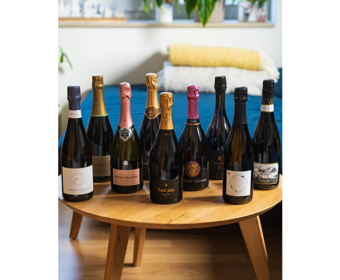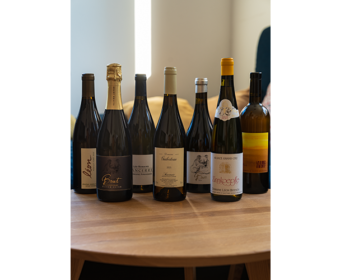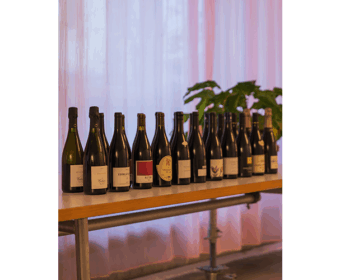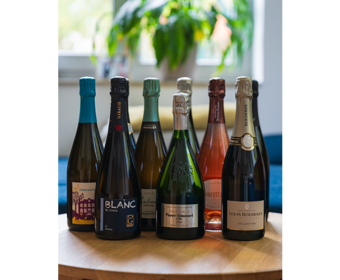Unbottled – French Red Tasting
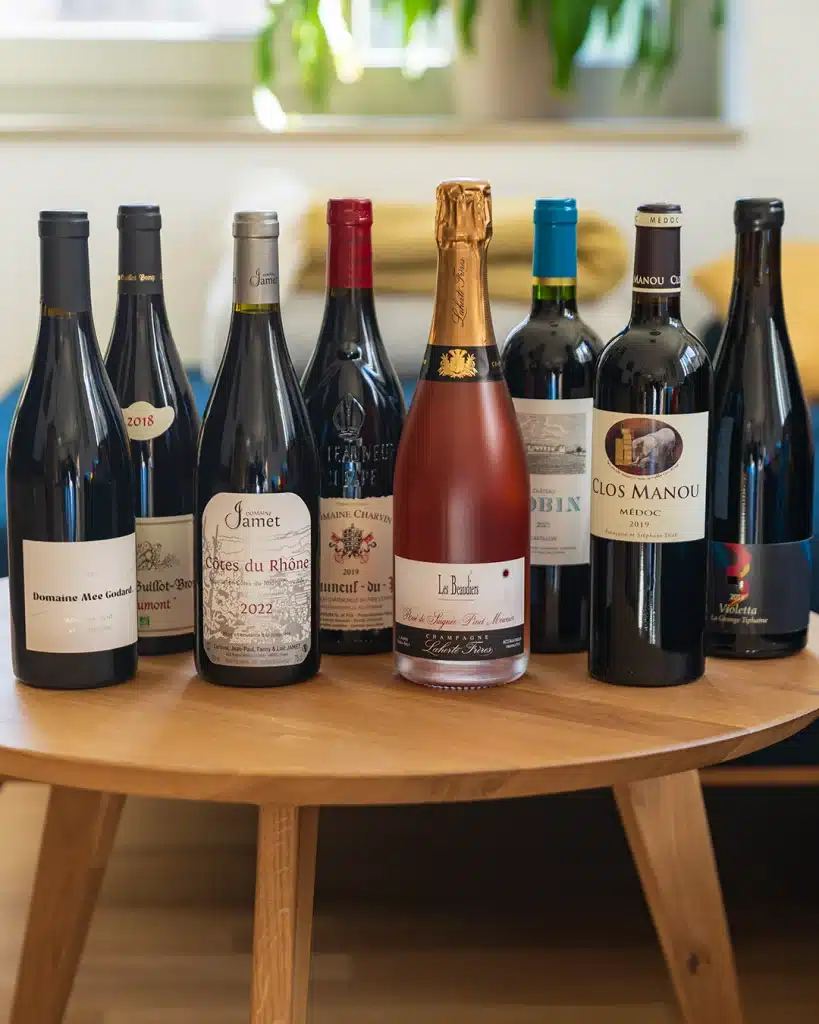
The latest tasting at our wine regular’s table was on French red wines. I tried to include the most famous regions. On top of that, we also comparted two wines each which had something in common. We started with a Beaujolais / Maconnais comparison, tried a wine from the Northern and one from the Southern Rhône as well as a right and a left-bank Bordeaux. Apart from that, I included a rosé champagne as a refresher and a Malbec from the Loire river.
Just shy of Burgundy

Domaine Mee Godard was the first vineyard in the tasting. I was introduced to this Beaujolais vineyard by a wine tasting at the Pinot winemerchant in Nuremberg. For this tasting, I included the Moulin à Vent Au Michelon, a rather special vineyard for Mee Godard, because it lies North of the rest of her vinyards in Morgon. The Gamay vines grow on pink granite with sand and 70 % of them are vinified as whole clusters. After a 17-day Macération Carbonique, the wine spends a year in neutral toasted barrels, Demi-Foudres and Foudres.
Primary fruit

The Au Michelon 2020 shows a lot of primary fruit with red berries, cherry juice and raspberries. A touch of green notes lingers on in the back. This way, the Gamay is a great crowd pleaser which delivers all the typical flavours you would expect from a French red. You may or may not decant this wine, since the tannins really are silky smooth.
Gamay or Pinot Noir?

Yes, I probably should have included a Pinot Noir from Burgundy. However, I was intrigued by the Gamay comparison. Besides that, I am planning separate Pinot Noir and Burgundy tastings anyway… The Guillot-Broux Mâcon-Cruzille Beaumont comes from the rather underrated Maconnais region. Yet, the organically grown Gamay grapes are treated like a Pinot Noir. The vinyard has a planting density of 9000 vines per hectare. Apart from that, the whole grapes are mashed by foot and ferment in open vats. In the end, the Beaumont ages for 18 months in used barrique barrels.
Demanding tannins

When comparing the first two reds, you would not instantly think both come from the same grape variety. Minerals and umami notes dominate the Guillot-Broux’s taste with dark fruits coming in second. The wine shows a pronounced tannin structure which really longs for some time in the decanter. Yet, with some air the Gamay graps your attention and creates an exciting drinking flow.
Underrated once again

For a wine from the Northern Rhône, I went with a Côte du Rhône from renown vineyard Jean-Paul & Corinne Jamet. This Syrah comes from the Lieu-dits Lézardes, Cognet, Plomb, Champrond and Tartaras. The destemmed grapes macerate for two weeks on their skins and age in four to five-times used barrels.
Polarizing red

When freshly opened, the Jamet had a powerful vanilla flavour. After a while in the decanter, the aroma changes towards a combination of red fruits and umami notes. The latter, reminded me a bit of juniper bacon. In the taste, cassis, sour cherries and spices come to the front. The umami flavour changes towards more vegetal flavours in the taste. This Côte du Rhône polarized the tasters, some loved it others did not enjoy it at all.
One of the last of its kind

Chateauneuf-du-Papes surely are the most famous wines from the Rhône. As a comparison with the Jamet, we had the 2019 vintage from Charvin. Laurent Charvin does neither own a destemming-machine nor a press and also does not use oak. He only uses the free-run juice for his classic Chateauneuf-du-Pape Cuvèe of 75 % Grenache, 10 % Mourvèdre, 10 % Syrah, 5 % Carinena. After spontaneous fermentation, the wine ages for 21 months in concrete vats.
A powerhouse of a wine

Naturally, the Chateauneuf-du-Pape is a powerhouse of a wine! With almost 16 % you notice the alcohol in the aroma and taste. Besides that, you can find cherry liqueur, cherry jam and a lot of spices in the taste. I also tasted vanilla, leather and tobacco. Surely, this wine can age for decades and even then, needs some time in the decanter. You probably should open it the day before you want to enjoy it.
A little refresher

For a change from all the reds, I included a rosé champagne in the middle of the tasting. Yet, I chose a bottle which could stand up to all those tannins. The Laherte Freres Champagne Les Beaudiers Rosé de Saignée comes from a plot in Chavot. The Pinot Meunier vines were planted in 1953, 1958, as well as 1965. After a 12 h to 15 h maceration the grapes are pressed and spontaneously fermented in oak barrels. The base wine ages for 12 months on the lees and after the second fermentation the champagnes stays on the yeast for 48 months.
Excellent Pinot Meunier!

Luckily, my plan worked and the champagne did refresh everyone. Furthermore, it was the first bottle which we emptied on this evening. The champagne clearly reminded me of freshly backed baguette like no bottle before. Apart from that, I noticed red apples, red currants, raspberries, yeast and a touch of flint. Even though the champagne did not undergo malolactic fermentation the wine was not too sour. This definitely was one of the best rosé champagnes I ever tried!
Naturally, Bordeaux

Continuing with our red wine tasting, we arrived in Bordeaux – probably the most iconic French wine region. We started at the right bank of the Garonne river at the Chateau Robin. The Cuvée of 65 % Merlot, 25 % Cabernet Franc, 5 % Cabernet Sauvignon, 5 % Malbec is gently pressed and spontaneously fermented with temperature control in small open wooden vats and concrete tanks. Afterwards, the ageing takes place in French oak casks with just a small portion of new oak.
Great value-for-money

Even if the right bank of the Bordeaux region is more approachable in its youth, the wine does need air to open up its tannins. You get spices, leather, cloves and nutmeg in the aroma. Furthermore, the taste shows the same spices along with dark cherries, mint and red apples. All in all, the Chateau Robin comes at a great value-for-money and delivers everything you would expect from a French red.
The ”other” Bordeaux

Françoise and Stéphane Dief apply meticulous work for producing their Clos Manou wines in the Haut-Medoc region. After a selective manual harvest, they use special shaking tables for destemming and an additional laser selection. The Cuvée of 47 % Cabernet Sauvignon, 47 % Merlot, 4 % Petite Verdot, as well as 2 % Cabernet Franc ferments in wood and concrete with pumping over and immersion of the “cake”. Ageing takes 18 months in 70 % French barriques, 25 % in 7 hl concrete tanks, and 5 % in amphorae.
Even more time

This Bordeaux starts with a blend of dark fruits in the aroma along with some umami notes which reminded me of high-quality cheese. The umami taste mellows with decanting alongside the tannin structure which becomes softer. Yet, this wine even needs more time to age. This became clear in the tasting, even after decanting the tannins still were quite pronounced. Yet, I also found interesting vanilla, leather and tobacco flavours.
A natural red

Last but not least, I had a special wine prepared. The La Grange Tiphane Violetta comes from Amboise in the Loire valley. Winemaker Coralie Delecheneau spontaneously fermented the Cot (Malbec) grapes without pre-clarification in large amphorae. The wine ages for two years on the yeast with occasional air contact. Afterwards, the Violetta is bottled without filtration and without fining as well as only a minimal addition of sulphur.
On of the best

Simply put, this is one of the best red wines I have tasted so far! I only realized this when typing up my notes. The aroma starts with dark fruits, tobacco and spices, but also shows a certain florality. In the taste of the Malbec, you will find a potpourri of red and dark fruits which tend towards a “jammy” finish. However, you can still notice some flowers and an acidic backbone in the wine. I just could not resist ordering the last available bottles of this vintage in Germany.
In the end
In conclusion, even though this was – apart from one exception – a red wine only tasting, there was no boredom. Each bottle offered something unique and interesting, from different terroir to completely different red wine production styles. This tasting for sure showed how much fun it is to discover wine together with a group of friends!
*The fact that I received a product reviewed in this article for free, did not – in any way – influence the rating of said product. I received two decanters for free from Gabriel Glas and Zalto Glas.

